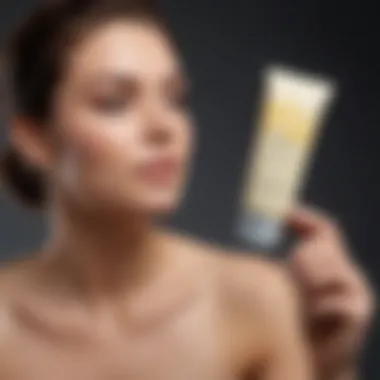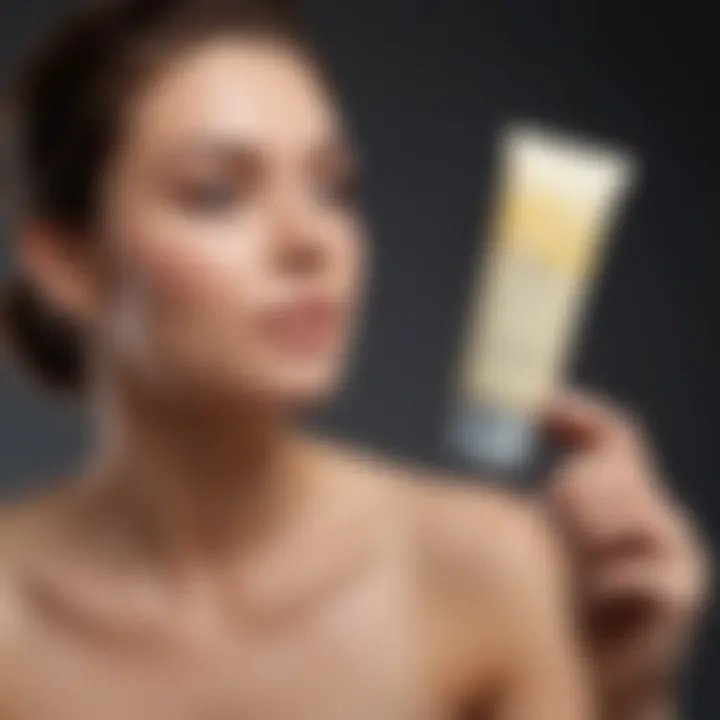Effective Methods for Managing Ingrown Hair in the Bikini Area


Intro
Ingrown hairs in the bikini area can quickly turn into an uncomfortable nuisance. For many women, this issue is not just about aesthetics but also about skin health and self-care. Identifying effective methods for managing and preventing these ingrown hairs is essential. This guide seeks to provide valuable insights into grooming techniques, skincare routines, and approaches to post-hair removal care.
Many may hold misconceptions about the causes and management of ingrown hairs. By understanding these factors, you can make informed decisions. Improved knowledge will empower you to maintain smoother skin and enhance your beauty regimen.
Fashion Trends
Seasonal Styles
When preparing for warmer months, fashion choices can naturally lead to increased awareness about skin appearance. Bikini season often prompts attention to this area. Wearing stylish swimwear can occasionally draw focus to discomfort caused by ingrown hairs. Thus, effective management becomes important in feeling confident.
Influencer Inspirations
Social media influencers frequently share their beauty routines, including how they tackle ingrown hairs. Observing these methods can offer direct insights. It might involve using specific creams or natural remedies. When seeking inspiration, consider their recommendations as a starting point.
Beauty Tips
Skincare Routines
Maintaining a consistent skincare routine is fundamental to addressing ingrown hairs. Exfoliating regularly helps remove dead skin cells. This can prevent hairs from becoming trapped beneath the skin. Look for gentle scrubs that suit sensitive areas.
- Exfoliate at least twice a week.
- Moisturize daily using non-comedogenic products.
- Cleanse with mild soaps to avoid irritation.
Makeup Techniques
While makeup may not directly affect ingrown hairs, enhancing the overall look of the bikini area can improve confidence. Using skin-toned concealers can help mask blemishes created by irritation. Always ensure that products are suitable for sensitive skin to avoid exacerbating issues.
Product Reviews
Trending Products
Several products have gained popularity for their effectiveness in reducing and preventing ingrown hairs. Look for ingredients like salicylic acid and tea tree oil, known for their soothing properties. Some noteworthy products include:
- Bump Patrol – A popular choice among women for post-shaving care.
- Tend Skin – Often recommended for its effectiveness against ingrown hairs.
Comparison Guides
Choosing the right product can be overwhelming. Consider evaluating several options before committing to one. Compare effectiveness, ingredient lists, and user reviews. Websites like Reddit or beauty blogs can also provide firsthand experiences shared by users.
"An informed choice is always better than a hasty one. Research helps in finding the most suitable products for your needs."
Ending
Understanding effective methods for managing ingrown hairs in the bikini area is a process. It requires adopting proper grooming techniques and skincare routines. It is essential to stay informed about trending products while also learning from the experiences of others. This comprehensive approach can result in smoother skin and a more confident outlook in personal care. It is crucial to remember that any treatment should be chosen based on individual skin needs.
Understanding Ingrown Hairs
Ingrown hairs represent a common skin condition that can lead to discomfort and even skin complications. Understanding this condition is vital for anyone looking to manage it effectively. Ingrown hairs occur when a hair curls back into the skin instead of growing outward. This can result in inflammation, irritation, and sometimes infection, particularly in sensitive areas such as the bikini region. Therefore, knowledge of ingrown hairs allows for informed decisions regarding hair removal techniques and post-removal care.
What Are Ingrown Hairs?
Ingrown hairs are strands of hair that grow back into the skin instead of rising up from it. This typically occurs when hair follicles become clogged with dead skin cells, bacteria, or sebum. The result is often a red, raised bump that resembles a pimple. In the bikini area, this issue is particularly noticeable due to the nature of hair removal methods commonly used, such as shaving or waxing. Understanding this phenomenon is the first step toward effective management and prevention.
Causes of Ingrown Hairs
There are several factors that contribute to the formation of ingrown hairs. Some of the primary causes include:
- Hair Removal Methods: Shaving, especially with a dull razor, can create sharp hair edges that are more likely to pierce the skin. Waxing can also contribute to the issue when hair is removed at an angle.
- Curly Hair: Individuals with naturally curly hair may experience more ingrown hairs. The shape of the hair makes it easier for it to grow back into the skin.
- Clogged Follicles: Skin that is not regularly exfoliated can lead to clogged pores, increasing the chances of ingrown hairs forming.
- Tight Clothing: Wearing tight underwear or clothing can irritate the sensitive bikini area, contributing to hair becoming trapped.
Common Areas Affected
While ingrown hairs can occur anywhere there is hair, certain areas are more prone to this condition. In terms of the bikini area, the most affected parts often include:
- Mons Pubis: The area above the genitalia where hair growth is common.
- Labia: Skin folds can trap hair and create an environment for ingrown hairs.
- Inner Thighs: This area can experience friction from clothing or skin-on-skin contact, exacerbating the issue.
Understanding these causes and areas affected by ingrown hairs provides a framework for effective management strategies. Addressing the underlying factors will aid in minimizing their occurrence and enhancing overall skin health.


Identifying Symptoms
Understanding ingrown hairs is not only about prevention and treatment but also about recognizing the symptoms that signal their presence. Identifying the symptoms early allows individuals to apply proper management techniques promptly, thus reducing the likelihood of further complications or discomfort. This section will explore the visual signs, pain associated with ingrown hairs, and the risk of potential infections. Each element plays a critical role in empowering women to take informed actions regarding their skin health.
Visual Signs of Ingrown Hairs
The most apparent indication of an ingrown hair is the formation of small, raised bumps on the skin, often resembling pimples. These bumps can vary in color, appearing red or darker than the surrounding skin. The skin surrounding the ingrown hair may show signs of irritation, such as redness or swelling.
Other visual signs include:
- Pus or fluid-filled blisters: These can develop if the hair remains trapped for an extended period, leading to a more significant inflammatory response.
- Discoloration or hyperpigmentation: Some individuals may notice darker spots on their skin where the ingrown hairs have occurred.
Vigilance in observing these signs is paramount, as early intervention can prevent further skin issues.
Associated Pain and Discomfort
Ingrown hairs can cause an array of sensations, ranging from mild discomfort to significant pain. The irritation typically occurs because the hair curls back into the skin instead of growing outward. Symptoms can include:
- Tenderness: The area around the ingrown hair can feel sensitive to the touch.
- Itching: The itching sensation can be quite bothersome and may lead to scratching, which increases the risk of infection.
- Sharp or throbbing pain: In more severe cases, pressure or inflammation can result in sharp pain or a throbbing feeling that may radiate to nearby areas.
Managing these sensations early through effective skincare routines is critical to long-term relief.
Potential Infections
If not addressed, ingrown hairs can lead to infections. Bacteria may enter the skin through the broken barrier created by the ingrown hair. This can escalate to:
- Cellulitis: A serious skin infection that can result in swelling, warmth, and increased pain around the area.
- Folliculitis: An infection of the hair follicles that can occur simultaneously with ingrown hairs, manifesting as additional bumps or pustules.
- Abscess formation: In severe cases, pus can accumulate under the skin, creating an abscess, which requires medical intervention.
"Being aware of the signs and symptoms allows individuals to take appropriate action before conditions worsen."
Maintaining vigilance regarding the symptoms helps in seeking timely treatment, preventing complications, and ensuring overall skin health.
Preventive Measures
Preventive measures are vital in tackling the persistent issue of ingrown hairs in the bikini area. Taking a proactive approach can significantly reduce the incidence of ingrown hairs. Focusing on hair removal methods, preparation, aftercare, and regular exfoliation forms a comprehensive strategy for maintaining skin health. Preventive care not only minimizes discomfort but also enhances overall skin appearance. It is essential to consider each aspect carefully for the best outcomes.
Choosing the Right Hair Removal Method
Selecting the appropriate hair removal method is crucial in preventing ingrown hairs. Techniques like shaving, waxing, or laser hair removal have different effects on the skin. Shaving can lead to sharper hair edges, which may more likely grow back into the skin. Waxing may reduce the frequency of ingrown hairs but can also cause sensitivity. Laser hair removal tends to offer a longer-term solution, but it may not be suitable for all skin types.
When considering hair removal, it is essential to evaluate personal skin sensitivity and hair type. For those prone to ingrown hairs, opting for methods like laser or electrolysis may be more effective. Conversely, if using shaving, ensure the razor is sharp and use a hydrating shave cream to soften hairs beforehand.
Preparation Before Hair Removal
Preparation plays a significant role in reducing the occurrence of ingrown hairs. Before any hair removal process, it is advisable to properly cleanse the skin to remove any dirt and excess oils. Applying a warm compress can help open pores, thereby allowing hair follicles to relax. It is also crucial to hydrate the skin with a suitable pre-shave oil or lotion. This can provide a protective barrier and prevent irritation during the process.
Consider testing your chosen hair removal product on a small area first. This way, you can gauge how your skin reacts to it. Additionally, avoid hair removal on broken skin or areas with visible irritation to prevent complications.
Post-Hair Removal Care
After hair removal, the skin requires special care to minimize irritation and prevent ingrown hairs. Gently rinsing the area with cool water can help close pores and soothe the skin. Applying an alcohol-free soothing lotion afterward will help in hydration and reduction of inflammation. It is recommended to avoid tight clothing for a day or two post-hair removal to allow the skin to breathe.
If there are areas with visible irritation, using a gentle anti-inflammatory cream or gel can provide relief. Keeping the skin moisturized is essential, so opting for a non-comedogenic moisturizer is advisable. It will help maintain smooth skin while preventing clogged pores.
Regular Exfoliation Practices
Incorporating regular exfoliation into your skincare routine can greatly aid in preventing ingrown hairs. This process helps to remove dead skin cells, allowing hair to grow freely without obstruction. Opt for a gentle exfoliating scrub specifically designed for sensitive areas.
Exfoliating two to three times a week can significantly enhance skin texture. Implementing chemical exfoliants such as salicylic acid or glycolic acid can also be beneficial, as they help break down dead skin cells more effectively. However, it is imperative to avoid over-exfoliating, as it can lead to skin irritation.
"Consistent exfoliation is essential not only for preventing ingrown hairs but also for maintaining overall skin health."
In summary, preventive measures play an important role in managing ingrown hairs in the bikini area. By choosing the right hair removal method, preparing adequately, caring for the skin post-removal, and maintaining a regular exfoliation routine, it is possible to minimize the risk of this common irritation. Each step contributes to healthier skin and a more comfortable grooming experience.
Effective Treatments for Ingrown Hairs
Managing ingrown hairs, especially in the bikini area, requires a thoughtful approach to treatment. This section provides clarity on various effective treatments available, emphasizing their significance in alleviating discomfort and promoting skin health. Knowing the right options can empower individuals to choose suitable methods for both treatment and prevention.
Home Remedies


Home remedies can be an accessible first line of defense against ingrown hairs. These natural solutions often leverage common kitchen ingredients and can offer relief without harsh chemicals. Some effective home remedies include:
- Warm compress: Applying a warm compress to the affected area can help soften the skin and may encourage the hair to break through.
- Tea tree oil: Known for its antibacterial properties, tea tree oil can aid in reducing inflammation and preventing infection. Dilute it with a carrier oil and apply it gently to the skin.
- Exfoliating scrub: Using sugar or coffee grounds mixed with coconut oil creates a gentle scrub that can clear away dead skin cells, helping to free ingrown hairs.
While these remedies can be beneficial, it is important to monitor the skin for any adverse reactions. If irritation occurs, discontinue use immediately.
Over-the-Counter Solutions
In addition to home treatments, over-the-counter solutions provide a wider range of options specifically designed for ingrown hairs. Some noteworthy products include:
- Salicylic acid products: These help to exfoliate the skin and prevent clogged pores which lead to ingrown hairs.
- Glycolic acid creams: They assist in promoting cell turnover, thus reducing the likelihood of hair becoming trapped beneath the skin.
- Hydrocortisone cream: This can reduce swelling and pain associated with ingrown hairs.
When selecting an over-the-counter product, it is wise to read the label carefully for ingredients and instructions, ensuring the chosen solution aligns with individual skin types and conditions. Regular use can deliver noticeable improvements over time.
When to Seek Professional Help
Professional support becomes important when home remedies or over-the-counter solutions do not yield desired results. There are several indicators that it may be time to consult a dermatologist:
"Persistent ingrown hairs could indicate underlying conditions affecting skin health."
- Severe Pain: If the discomfort becomes intense or debilitating.
- Signs of Infection: Redness, swelling, or pus may point to an infection that needs professional treatment.
- Recurrence: Frequent ingrown hairs despite proper care may warrant further evaluation.
A dermatologist can provide advanced treatments such as corticosteroid injections, laser hair removal, or even minor surgical procedures to extract deeply embedded hairs. Diagnosing underlying skin conditions, if present, can greatly enhance treatment efficacy.
By being aware of effective treatments for ingrown hairs, individuals can adopt a proactive and informed approach to skin care. Understanding the options available promotes better decision-making and paves the way for healthier skin in the bikini area.
Product Recommendations
The use of appropriate products can significantly reduce the chances of developing ingrown hairs in the bikini area. Choosing the right products for grooming, exfoliation, and post-care is essential. These products can help manage skin health effectively and minimize irritation. A well-thought-out selection of shaving creams, exfoliating scrubs, and soothing moisturizers creates a comprehensive approach to hair removal and maintenance.
Shaving Creams and Gels
Using quality shaving creams and gels is vital for a smooth hair removal process. They provide lubrication and hydration, which can lessen the risk of irritation. Look for products containing natural ingredients such as aloe vera or chamomile for their soothing properties. Avoid those with harsh chemical additives.
- Hydration: Moisturizing products help keep the skin soft. This can allow the hairs to exit the follicle without curling back.
- Protection: A good cream forms a protective barrier, reducing friction. This may prevent breakouts and rash in this sensitive area.
- Easy application: Gels often provide more visibility during shaving.
Exfoliating Scrubs
Regular exfoliation is crucial. Exfoliating scrubs help remove dead skin cells, preventing hairs from becoming trapped. Look for gentle, non-abrasive scrubs designed specifically for sensitive skin. Those with ingredients like salicylic acid can help clear clogged pores, promoting healthy hair growth.
- Frequency: Using an exfoliating scrub two to three times a week can optimize results.
- Method: When scrubbing, use gentle circular motions. Avoid aggressive scrubbing, which can cause further irritation.
- Ideal formulations: Seek scrubs with added moisturizing components, so the skin does not dry out after use.
Moisturizers and Soothing Creams
After hair removal or exfoliation, it is essential to apply a high-quality moisturizer or soothing cream. This aids in calming the skin, reducing redness, and providing essential hydration. Ingredients to look for include shea butter, vitamin E, and tea tree oil.
- Before application: Ensure your skin is clean and slightly damp for better absorption.
- Aftercare: Apply moisturizers immediately following hair removal to lock in moisture.
- Regular use: Consistent application can improve overall skin texture, making it less prone to irritation and ingrown hairs.
"Choosing the right products is not just about preference; it can influence the effectiveness of your hair removal routine."
Overall, investing time in selecting suitable shaving creams, exfoliating scrubs, and moisturizers can lead to significant improvements in skin health. This proactive approach can reduce the likelihood of ingrown hairs, promoting comfort and confidence.
Lifestyle Factors Influencing Ingrown Hairs
Understanding lifestyle factors is essential when discussing ingrown hairs, especially in the bikini area. Lifestyle choices, from diet to clothing and even psychological stress, play a significant role in the condition of the skin. Healthy skin is less likely to suffer from irritations that lead to ingrown hairs. By addressing various aspects of everyday life, individuals can cultivate better skin health, thereby reducing the occurrences of ingrown hairs.
Diet and Hydration
Diet significantly affects skin health. Consuming a balanced diet rich in vitamins and minerals is vital for maintaining skin elasticity and healing capabilities. Nutrients such as vitamins A, C, and E can help enhance skin vitality.
- Fruits and Vegetables: Foods like berries, oranges, and leafy greens are packed with antioxidants and hydration properties that benefit skin health.
- Omega-3 Fatty Acids: Found in fish, flaxseeds, and walnuts, these fatty acids can help reduce inflammation and keep skin moist.
Staying hydrated is also crucial. Drinking enough water supports skin elasticity and can help in flushing out toxins. Dehydrated skin may become rough and more prone to irritation during hair removal processes.
Microfiber Clothing Choices
Fabric choice impacts skin health significantly. Microfiber clothing is known for its softness and breathability. These types of fabrics reduce friction against the skin, which can minimize irritation and discomfort in sensitive areas. Tight clothing, on the other hand, can trap moisture and create the perfect environment for ingrown hairs to develop. Opting for loose and breathable garments helps in preventing these occurrences.
Considerations for clothing:


- Choose breathable fabrics: Cotton and microfiber allow airflow and help the skin to remain dry and comfortable.
- Avoid tight-fitting garments: Clothing that is too tight can cause friction and lead to hair growing back into the skin.
Stress and Skin Health
Stress can have a profound impact on overall skin health. Elevated stress levels can lead to hormonal fluctuations that may exacerbate skin issues, including ingrown hairs. This is particularly relevant in women who may experience changes in skin oil production due to stress.
Here are some effects of stress on skin health:
- Hormonal Imbalances: Stress can cause an increase in androgens, leading to oilier skin and more pronounced hair growth.
- Poor Healing: Stress can slow down the healing process of already damaged skin, making irritated areas more sensitive.
Utilizing stress management techniques, such as mindfulness practices or physical exercise, can be beneficial not only for mental well-being but also for maintaining skin health.
"Understanding your lifestyle choices can be a game changer for managing ingrown hairs in the bikini area. The small shifts can lead to more significant improvements over time."
Adapting your diet, choosing appropriate clothing, and managing stress are foundational elements in an effective strategy to prevent ingrown hairs. These aspects should be integrated into your daily routine for long-term skin health.
Myths and Realities
Understanding the myths and realities surrounding ingrown hairs is crucial for effective management, especially in the sensitive areas such as the bikini region. Many women are influenced by misinformation, which can lead to ineffective treatments or unnecessary distress. Addressing these misconceptions helps provide clarity and promotes better skincare practices. Moreover, recognizing the realities can empower individuals to take informed steps toward prevention and effective management of ingrown hairs.
Common Misunderstandings
Various myths contribute to confusion about ingrown hairs. Here are some of the prevalent misunderstandings:
- All Hair Removal Methods Cause Ingrown Hairs: While certain methods like shaving and waxing increase the risk, not all techniques lead to ingrown hairs. Proper techniques reduce this risk significantly.
- Ingrown Hairs Are Just a Cosmetic Issue: Many see this condition as merely aesthetic. However, ingrown hairs can lead to real physical discomfort, including redness, itching, and potential skin infections.
- You Should Always Remove Ingrown Hairs: Some believe in removing ingrown hairs forcefully or prematurely. This can aggravate the situation and potentially cause scars or infections rather than providing relief.
Debunking Popular Myths
Several popular myths also shape perceptions about ingrown hairs. Here are a few:
- Myth 1: Only People with Curly Hair Get Ingrown Hairs: This is inaccurate. While individuals with curly hair may experience more ingrown hairs due to the hair's natural growth angle, anyone can develop them regardless of hair type.
- Myth 2: Using a Single Blade Razor Is the Best Approach: Many think that single blade razors are less likely to cause ingrown hairs; however, the technique of shaving is more critical. Using a proper technique, along with a moisturizing shaving cream, can minimize the risk.
- Myth 3: Ingrown Hairs Will Go Away Without Treatment: While it's true some ingrown hairs can resolve over time, many need intervention to alleviate discomfort and prevent complications. Regularly treating potential ingrown hairs is recommended.
Understanding these myths allows women to navigate their skincare routines more effectively. By identifying what is true and what is not, one can develop a holistic approach to managing ingrown hairs and maintaining skin health. >“Education is the key to normalizing the experience and promoting healthy habits.”
With proper knowledge, applying the right techniques can yield significant benefits and reduce the occurrence of ingrown hairs in the bikini area.
Maintaining Long-term Skin Health
Maintaining long-term skin health is crucial, especially in the bikini area, where skin is sensitive and prone to complications like ingrown hairs. This section prioritizes tailored grooming practices, effective skincare regimens, and the importance of consulting dermatological professionals. By focusing on these elements, individuals can minimize discomfort and prevent the occurrence of ingrown hairs over time.
Adaptation of Grooming Routines
Adapting grooming routines to align with individual skin types is a foundational step in reducing the risk of ingrown hairs. Shaving or waxing methods must be chosen appropriately based on hair growth patterns and skin sensitivity. For example, those with curly hair should consider a different approach compared to those with straight hair.
It might be advisable to switch from traditional shaving to electric trimmers or natural hair removal techniques that cause less irritation. Additionally, incorporating regular moisturizing into your routine is vital. Using non-comedogenic products can help keep the hair follicles clear and reduce inflammation. Like this, habits like shaving in the direction of hair growth and avoiding pressure on the skin can significantly improve overall skin health.
Establishing a Skincare Regimen
An effective skincare regimen tailored for the bikini area should include gentle exfoliation, hydration, and protective measures. Exfoliating helps remove dead skin cells that can block hair follicles, thus reducing the chances of ingrown hairs. Aim for a mild scrub or chemical exfoliant a few times per week, allowing the skin to renew while maintaining its integrity.
Hydration is another essential aspect of skincare. Moisturizers designed for sensitive skin will not only maintain balance but also soothe any irritation that may arise from grooming. It is advisable to choose products with soothing ingredients like aloe vera or chamomile.
Protecting the skin from environmental stressors is also important. Use sun protection, especially if you participate in activities that expose the bikini area. This proactive approach enhances skin resilience, contributing to long-term health.
Consulting Dermatological Professionals
Consulting dermatological professionals can be an invaluable resource when facing persistent ingrown hairs or skin irritation. Dermatologists can provide personalized assessments regarding skin type and sensitivities. Such expertise allows for the formulation of a specialized care plan that may include prescription treatments or tailored product recommendations.
Regular consultations might lead to preventative strategies that individuals may not consider on their own. Additionally, dermatologists can assist in identifying any underlying skin conditions that contribute to the issue of ingrown hairs. They can direct individuals toward effective treatments that can alleviate current concerns while promoting healthier skin in the long run.
"Investing time in skincare now can prevent discomfort later. Prioritize your skin health to enjoy long-lasting results."
Closure
Recap of Key Strategies
Ingrown hairs can be an impediment to enjoying smooth skin in the bikini area. However, the article has provided several crucial strategies to manage and prevent this common concern:
- Choosing the Right Hair Removal Method: Selecting appropriate techniques, such as laser hair removal or proper shaving, can significantly reduce the risk of ingrown hairs.
- Preparation and Post-Care: Effective skin preparation before hair removal, combined with diligent aftercare, is pivotal. This includes cleansing and moisturizing to maintain skin health.
- Regular Exfoliation: Engaging in regular exfoliation helps keep skin clear and can prevent hair from becoming trapped beneath the surface.
- Understanding Lifestyle Influences: Recognizing how diet, clothing choices, and stress affect skin health is equally important. Making mindful adjustments in these areas can have a noticeable impact.
By implementing these strategies, individuals can take proactive steps towards preventing and managing ingrown hairs effectively.
Encouragement for Proactive Care
It is critical to adopt a proactive approach in skin care routines. Regular attention to the bikini area through proper grooming and skin maintenance not only prevents ingrown hairs but also fosters an overall sense of personal wellness. The importance of self-awareness in identifying symptoms of ingrown hairs cannot be overstated. Being attentive to changes in skin texture or discomfort can allow for timely intervention.



